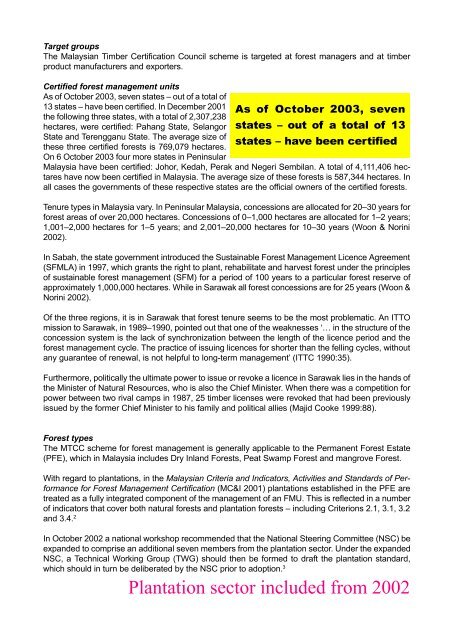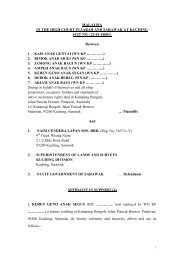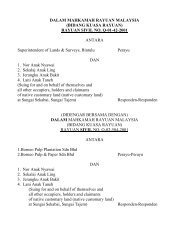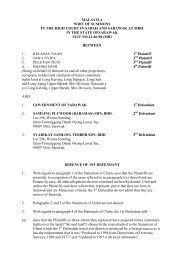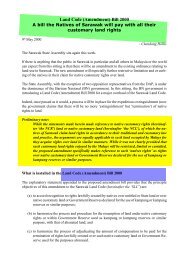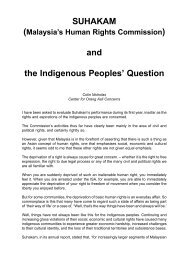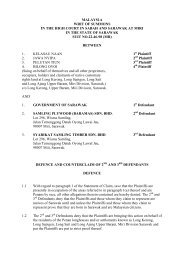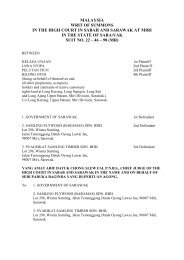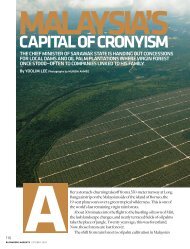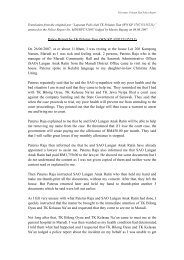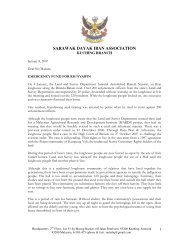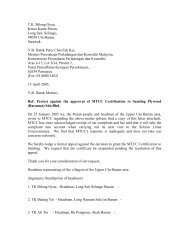A Report on the Malaysian Timber Certification Scheme - Rengah ...
A Report on the Malaysian Timber Certification Scheme - Rengah ...
A Report on the Malaysian Timber Certification Scheme - Rengah ...
Create successful ePaper yourself
Turn your PDF publications into a flip-book with our unique Google optimized e-Paper software.
Target groups<br />
The <strong>Malaysian</strong> <strong>Timber</strong> Certificati<strong>on</strong> Council scheme is targeted at forest managers and at timber<br />
product manufacturers and exporters.<br />
Certified forest management units<br />
As of October 2003, seven states – out of a total of<br />
13 states – have been certified. In December 2001 As of October 2003, seven<br />
<strong>the</strong> following three states, with a total of 2,307,238<br />
hectares, were certified: Pahang State, Selangor states – out of a total of 13<br />
State and Terengganu State. The average size of<br />
states – have been certified<br />
<strong>the</strong>se three certified forests is 769,079 hectares.<br />
On 6 October 2003 four more states in Peninsular<br />
Malaysia have been certified: Johor, Kedah, Perak and Negeri Sembilan. A total of 4,111,406 hectares<br />
have now been certified in Malaysia. The average size of <strong>the</strong>se forests is 587,344 hectares. In<br />
all cases <strong>the</strong> governments of <strong>the</strong>se respective states are <strong>the</strong> official owners of <strong>the</strong> certified forests.<br />
Tenure types in Malaysia vary. In Peninsular Malaysia, c<strong>on</strong>cessi<strong>on</strong>s are allocated for 20–30 years for<br />
forest areas of over 20,000 hectares. C<strong>on</strong>cessi<strong>on</strong>s of 0–1,000 hectares are allocated for 1–2 years;<br />
1,001–2,000 hectares for 1–5 years; and 2,001–20,000 hectares for 10–30 years (Wo<strong>on</strong> & Norini<br />
2002).<br />
In Sabah, <strong>the</strong> state government introduced <strong>the</strong> Sustainable Forest Management Licence Agreement<br />
(SFMLA) in 1997, which grants <strong>the</strong> right to plant, rehabilitate and harvest forest under <strong>the</strong> principles<br />
of sustainable forest management (SFM) for a period of 100 years to a particular forest reserve of<br />
approximately 1,000,000 hectares. While in Sarawak all forest c<strong>on</strong>cessi<strong>on</strong>s are for 25 years (Wo<strong>on</strong> &<br />
Norini 2002).<br />
Of <strong>the</strong> three regi<strong>on</strong>s, it is in Sarawak that forest tenure seems to be <strong>the</strong> most problematic. An ITTO<br />
missi<strong>on</strong> to Sarawak, in 1989–1990, pointed out that <strong>on</strong>e of <strong>the</strong> weaknesses ‘… in <strong>the</strong> structure of <strong>the</strong><br />
c<strong>on</strong>cessi<strong>on</strong> system is <strong>the</strong> lack of synchr<strong>on</strong>izati<strong>on</strong> between <strong>the</strong> length of <strong>the</strong> licence period and <strong>the</strong><br />
forest management cycle. The practice of issuing licences for shorter than <strong>the</strong> felling cycles, without<br />
any guarantee of renewal, is not helpful to l<strong>on</strong>g-term management’ (ITTC 1990:35).<br />
Fur<strong>the</strong>rmore, politically <strong>the</strong> ultimate power to issue or revoke a licence in Sarawak lies in <strong>the</strong> hands of<br />
<strong>the</strong> Minister of Natural Resources, who is also <strong>the</strong> Chief Minister. When <strong>the</strong>re was a competiti<strong>on</strong> for<br />
power between two rival camps in 1987, 25 timber licenses were revoked that had been previously<br />
issued by <strong>the</strong> former Chief Minister to his family and political allies (Majid Cooke 1999:88).<br />
Forest types<br />
The MTCC scheme for forest management is generally applicable to <strong>the</strong> Permanent Forest Estate<br />
(PFE), which in Malaysia includes Dry Inland Forests, Peat Swamp Forest and mangrove Forest.<br />
With regard to plantati<strong>on</strong>s, in <strong>the</strong> <strong>Malaysian</strong> Criteria and Indicators, Activities and Standards of Performance<br />
for Forest Management Certificati<strong>on</strong> (MC&I 2001) plantati<strong>on</strong>s established in <strong>the</strong> PFE are<br />
treated as a fully integrated comp<strong>on</strong>ent of <strong>the</strong> management of an FMU. This is reflected in a number<br />
of indicators that cover both natural forests and plantati<strong>on</strong> forests – including Criteri<strong>on</strong>s 2.1, 3.1, 3.2<br />
and 3.4. 2<br />
In October 2002 a nati<strong>on</strong>al workshop recommended that <strong>the</strong> Nati<strong>on</strong>al Steering Committee (NSC) be<br />
expanded to comprise an additi<strong>on</strong>al seven members from <strong>the</strong> plantati<strong>on</strong> sector. Under <strong>the</strong> expanded<br />
NSC, a Technical Working Group (TWG) should <strong>the</strong>n be formed to draft <strong>the</strong> plantati<strong>on</strong> standard,<br />
which should in turn be deliberated by <strong>the</strong> NSC prior to adopti<strong>on</strong>. 3<br />
Plantati<strong>on</strong> sector included from 2002


